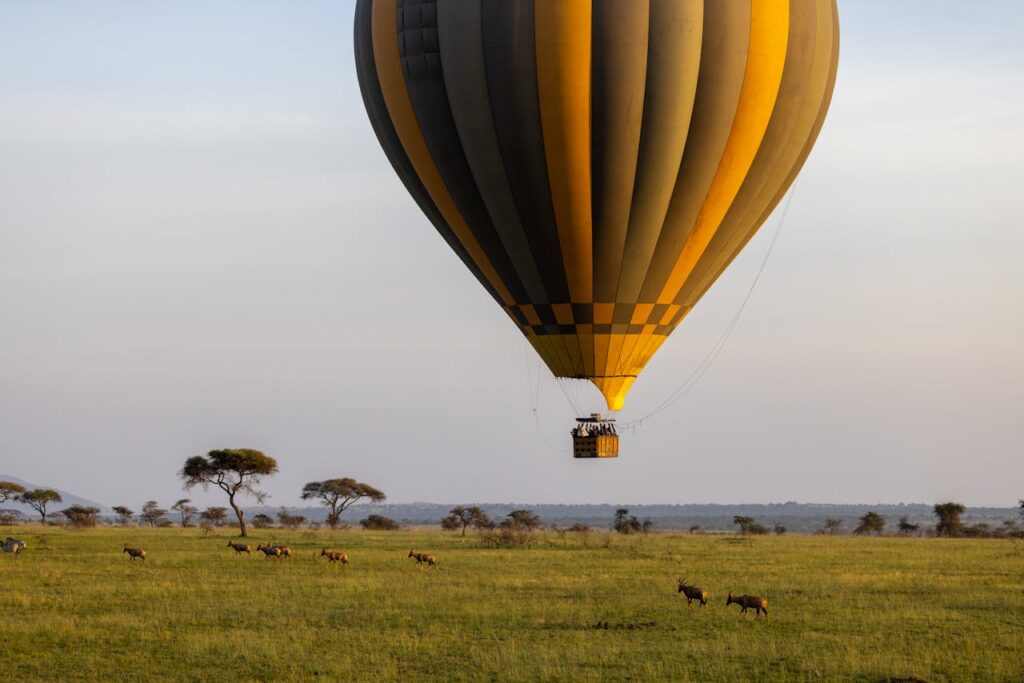I. Introduction
The Adumu dance, widely recognized as the Maasai jumping dance, is one of the most captivating and symbolic cultural performances in Africa. It is a vital part of the Maasai warrior tradition, serving as both an initiation rite and a display of strength and endurance. This dance, which involves young Maasai men leaping into the air in a display of agility and power, has become one of the most iconic images associated with the Maasai people of Kenya and Tanzania. As a key attraction for cultural tourism, the Adumu dance is both a preserved tradition and a widely showcased performance.
This guide delves deep into the origin, meaning, and significance of the Adumu dance, explores how it is performed, and provides insights into ethical ways to experience it during a Maasai village visit.
II. Origin and History of the Adumu Dance
Adumu Dance History and Origins
The Adumu dance has its roots in the Maasai age-set system, which divides men into different social categories based on age and responsibilities. The dance is performed during the Eunoto ceremony, marking the transition of Morans (young warriors) into senior warriors. This initiation process is a significant milestone, as it prepares young Maasai men for adulthood and community leadership.
Historically, the dance was also linked to lion hunting rituals, where warriors demonstrated their courage and ability to protect the community. While lion hunting is now banned due to conservation efforts, the dance remains an important rite of passage and symbol of Maasai resilience.
Cultural Importance of the Adumu Dance
- Used to demonstrate physical prowess and warrior status.
- A core part of ceremonial rituals and social bonding.
- Represents endurance, bravery, and masculinity.
- Strengthens community ties and preserves Maasai heritage.
III. Meaning and Symbolism of the Adumu Dance
Significance of the Adumu Dance
The word Adumu translates to “jumping up and down” in the Maasai language. However, the dance is much more than a mere jumping contest. It symbolizes:
- Strength and Vitality: Warriors must showcase their stamina by jumping high while maintaining perfect posture.
- Social Status: The higher a warrior jumps, the more he is admired within the community.
- Rite of Passage: It signifies the transition from youth to warriorhood.
- Attraction Ritual: Women often watch and assess warriors based on their jumping ability.
IV. How the Adumu Dance is Performed
Adumu Dance Steps
- Formation & Chanting: The warriors form a semicircle, singing deep rhythmic chants.
- Jumping Sequence: One or two warriors step forward and leap straight into the air, keeping their feet close together.
- Posture & Style: Arms remain at the sides, and jumps should appear effortless and controlled.
- Call-and-Response Singing: The rest of the group encourages the jumper by intensifying the chants.
- Competitive Element: Warriors take turns, pushing each other to jump higher.
Traditional Attire and Music
- Shukas: Red and blue Maasai robes symbolizing strength and unity.
- Beaded Jewelry: Warriors wear elaborate necklaces and earrings.
- Chants & Drumming: Deep-toned chants set the rhythm, often accompanied by simple percussive beats.
V. The Adumu Dance in Modern Times
Adumu Dance for Tourists
In recent years, the Adumu dance has become a popular performance for visitors to Maasai villages. While some experiences are authentic, others are commercialized for entertainment purposes. Ethical travelers should seek culturally respectful experiences that provide direct benefits to the Maasai community.
Adumu Dance in Kenya & Tanzania
- Kenya: Best experienced in Maasai Mara, Amboseli, and Samburu.
- Tanzania: Common in Maasai settlements near Serengeti and Ngorongoro Crater.
Comparison with Other African Dances
While the Adumu dance is unique to the Maasai, other East African tribes have their own jumping dances. However, none have gained the international recognition of the Adumu, which has become a symbol of African warrior strength.
VI. Where to See the Adumu Dance
Best Places to Watch the Adumu Dance
- Maasai Mara Cultural Villages – Experience the dance in a natural setting.
- Maji Moto Eco Camp – Offers immersive experiences beyond staged performances.
- Local Festivals & Special Events – Some communities host public displays.
Adumu Dance Festivals and Events
Occasionally, the dance is performed during special Maasai gatherings, celebrations, and even safari lodge cultural nights.
VII. Ethical Considerations for Experiencing the Adumu Dance
Adumu Dance Tourism & Commercialization
- Some performances are staged purely for tourism, diluting their authenticity.
- Ethical tourism supports Maasai-run programs that empower local communities.
How to Experience an Ethical Adumu Dance
- Choose community-led tours over commercialized exhibitions.
- Pay fair compensation to local performers.
- Avoid intrusive photography without permission.
- Engage in respectful dialogue about Maasai traditions and beliefs.
VIII. Booking an Adumu Dance Experience
How to Book an Authentic Experience
- Look for ethical tour operators offering cultural immersion programs.
- Stay in Maasai-run lodges like Maji Moto Eco Camp.
- Join organized Maasai village visits that respect traditions.
Live Performances vs. Village Visits
- Some safaris include hotel-based performances, but these are often choreographed for guests.
- Visiting a real Maasai village provides a deeper, more meaningful experience.
IX. Interesting Facts About the Adumu Dance
Fascinating Insights
- Warriors can jump as high as 3 feet (90 cm) in the air.
- The dance is performed without musical instruments, relying solely on vocal chants.
- Some young Maasai men practice the dance daily to perfect their jumping technique.
X. Conclusion
The Adumu dance remains one of the most visually striking and culturally significant traditions of the Maasai people. It represents warriorhood, social ranking, and endurance, making it an unmissable experience for visitors to Kenya and Tanzania. However, to ensure a truly authentic and ethical experience, travelers should prioritize community-led initiatives that celebrate and sustain Maasai culture.
Witnessing or participating in this iconic dance is an opportunity to connect with one of Africa’s most famous indigenous tribes while gaining deeper insights into their traditions, resilience, and way of life.
Frequently Asked Questions (FAQs) About the Adumu Dance
1. Is the Adumu dance only performed by Maasai men?
Yes, traditionally, the Adumu dance is performed exclusively by young Maasai warriors (Morans) as part of their initiation ceremonies. Women play a significant role in the celebrations, often chanting, singing, and providing encouragement, but they do not participate in the jumping aspect of the dance.
2. How do Maasai warriors train to jump so high?
Maasai warriors develop their impressive jumping ability through daily physical activities such as herding cattle, running long distances, and practicing the Adumu dance itself. Their lean, muscular build and a diet rich in milk, blood, and meat contribute to their agility and strength.
3. What is the highest recorded jump in an Adumu dance?
While there is no official record, some Maasai warriors are known to jump up to 3 feet (90 cm) in the air. The key is maintaining perfect posture while jumping straight up without bending the knees, which makes it even more impressive.
4. Do Maasai children learn the Adumu dance?
Yes, young Maasai boys observe and practice the dance from an early age. However, they only officially participate after going through initiation rites when they become Morans (young warriors). The dance is part of their cultural education and preparation for adulthood.
5. How do Maasai people select the best jumper?
Jumping in the Adumu dance is not just about height—it also requires grace, endurance, and rhythm. The best jumper is often recognized by:\n
- Height of jumps
- Consistency in leaping multiple times without exhaustion
- Ability to maintain an upright posture while jumping
- Admiration from fellow warriors and village members
6. Is there a spiritual meaning behind the Adumu dance?
Yes, the dance has deep spiritual significance in Maasai culture. It symbolizes connection with ancestral spirits, strength, and unity. Some elders believe that the higher a warrior jumps, the closer he is to the spirits of great warriors who came before him.
7. Can tourists participate in the Adumu dance?
Yes, tourists are often invited to join the dance, but usually as a fun cultural exchange rather than as part of a real initiation ceremony. Visitors are encouraged to try jumping, but they are expected to show respect for Maasai traditions and follow the warriors’ lead.
8. What should I wear if I want to participate in the Adumu dance?
If you are invited to join the dance, wearing light, comfortable clothing and shoes with good support is recommended. If visiting a Maasai village, you might be offered a Shuka (traditional Maasai robe) to wear, which adds to the cultural experience.
9. What happens after the Adumu dance during a Maasai ceremony?
In a traditional setting, the Adumu dance is just one part of a larger ceremonial event. After the dance, there may be:
- Storytelling sessions by elders about Maasai history and warriorhood.
- Blessings by village elders for the young warriors.
- Feasting on milk, meat, and blood, which are key elements of the Maasai diet.
10. Is the Adumu dance performed at Maasai weddings?
While the Adumu dance is not a primary part of Maasai weddings, dances and singing do play an important role in wedding ceremonies. Warriors may perform the dance during wedding celebrations, but it is more commonly associated with warrior initiation rituals.
11. Can the Adumu dance be seen outside of Kenya and Tanzania?
Yes, the Maasai are often invited to perform at cultural festivals, tourism events, and international exhibitions worldwide. However, for an authentic experience, it is best to witness the dance in a real Maasai village in Kenya or Tanzania.
12. What is the best time of year to see the Adumu dance?
The best time to witness an authentic Adumu dance is during Maasai initiation ceremonies, which usually take place during dry seasons (June to October & January to March). However, many Maasai villages perform the dance year-round for cultural tourism experiences.
13. How can I respectfully photograph or film the Adumu dance?
Always ask for permission before taking photos or videos. Some Maasai communities appreciate sharing their traditions, while others may request a small donation or prefer not to be filmed. Being polite and respectful is key.
14. Is the Adumu dance included in all Maasai village tours?
Not all Maasai village visits include the Adumu dance. Some tours focus more on storytelling, traditional crafts, and daily life, while others highlight warrior activities, including the dance. Researching and booking with ethical tour operators will help ensure an authentic experience.
15. How does the Adumu dance compare to other jumping dances in Africa?
While the Adumu dance is the most famous jumping dance, other African tribes, such as the Zulu of South Africa, also have warrior dances that involve leaping. However, the precision, posture, and cultural depth of the Maasai’s Adumu make it unique.

